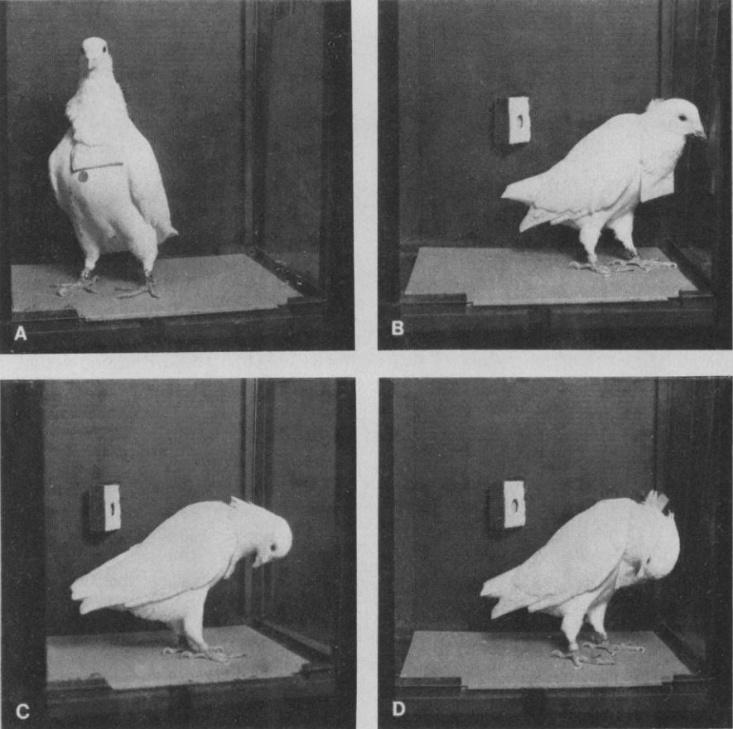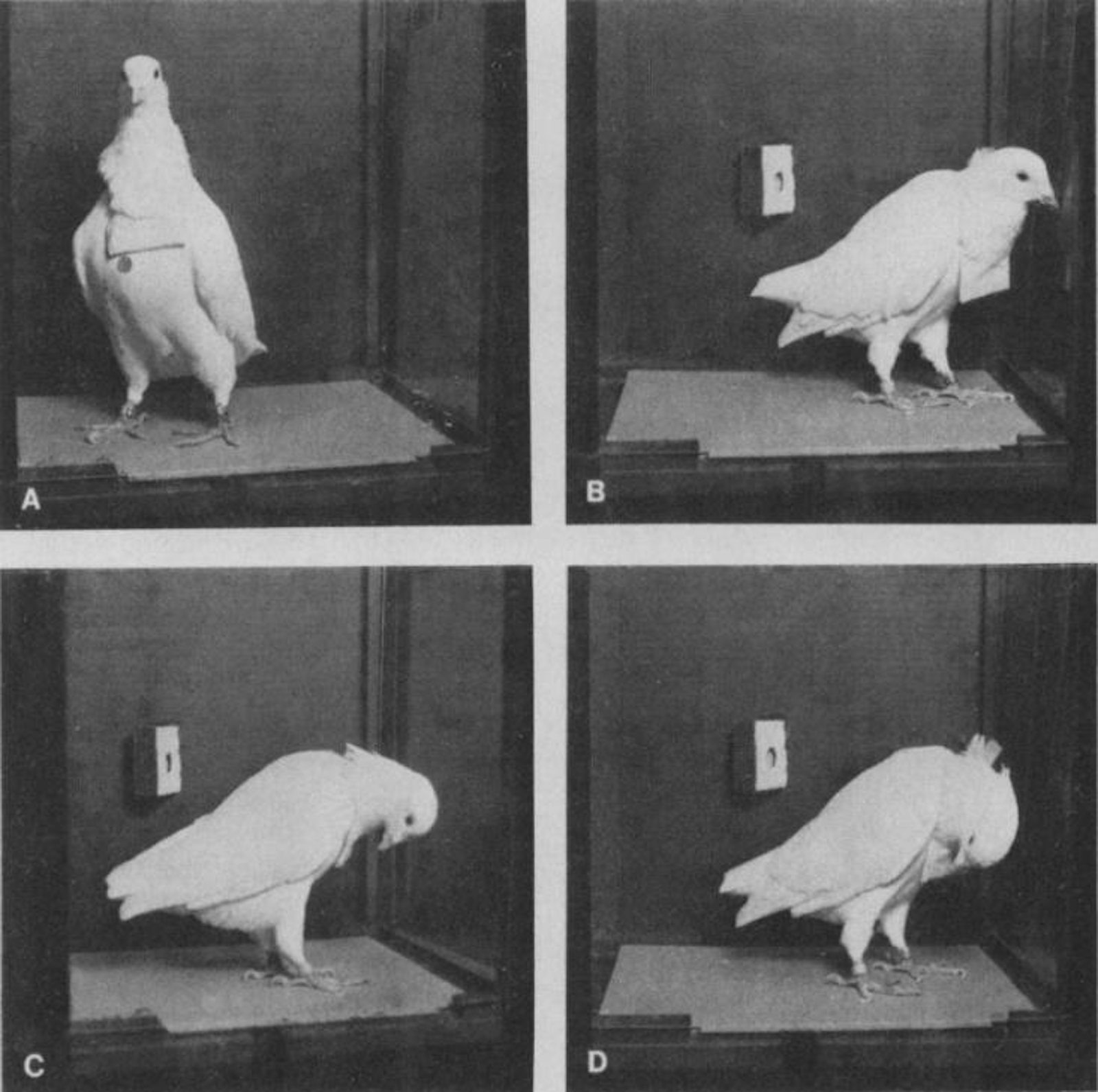A pigeon looks at its reflection in the mirror. It sees a blue dot on the reflection’s breast. It reaches down and pecks at the dot on its own breast.
This is the classic behavior required for passing the “mirror test,” an influential experiment used to test for self-awareness in animals. Chimpanzees became the first animal to pass the test, in 1969; 12 years later, a report in Science claimed that pigeons cleared the bar. Last month researchers reported in the Journal of the Experimental Analysis of Behavior that they had replicated that experiment. But most scientists, including the authors of the recent paper, downplay the importance of the result, insisting that pigeons have not demonstrated the self-awareness that the mirror test is assumed to test for. This apparent contradiction highlights how hard it is to understand the minds of creatures who have yet to tell us just what they’re thinking.
The debate over interpreting the mirror test goes back more than 40 years. I first wrote about the test in the Nautilus feature “What Do Animals See in a Mirror?” I explained how Gordon G. Gallup, Jr., published a series of experiments in Science in 1970 showing that chimpanzees—but not monkeys—could recognize themselves in mirrors. After observing that the chimps used a mirror to explore hard-to-examine parts of their own bodies, like the insides of their mouths, Gallup surreptitiously placed marks on their eyebrows and ears, where they couldn’t see them. The chimps looked in the mirror and touched the spots, indicating that they understood that the chimps in the mirror were themselves. Gallup proposed that this mirror self-recognition was evidence of a more general self-awareness in great apes that was akin to human self-awareness or even consciousness. But as I explain in the story, even though it’s often taken as proof positive of animal consciousness, that interpretation was and remains controversial.
The recent pigeon study resurfaces some of the important questions about the mirror test. One of the first challengers of the test was renowned psychologist B.F. Skinner of Harvard University. Skinner was a leading proponent of radical behaviorism, which had been the most prominent school of psychology until the rise of cognitivism, the school that still dominates today. “Behavioristic approaches are based on the proposition that all things animals do, including thinking, acting, and feeling, can be regarded as behaviors. They can be understood without reference to internal events or hypothetical constructs such as the mind,” according to historian and psychologist Donald A. Dewsbury. In other words, Skinner thought that using the mirror test to speculate about the minds of animals was just bad science.

To prove that the mirror test might mean absolutely nothing, he and his colleagues Robert Epstein and Robert Lanza investigated how pigeons would fare on it. Pigeons won’t naturally use a mirror to explore their own bodies. But over a 10-day training period, his team got three pigeons to peck at blue dots that they could see on their bodies, by rewarding them with food. Then they got the pigeons to use a mirror to find blue dots on the wall behind them and peck at them. Finally they put blue dots on the pigeons’ chests and put bibs on the birds that prevented them from seeing the dot directly. But the pigeons, thanks to their training, located the dots in the mirror and pecked at them on their own chests, technically passing the mirror test.
The tone of Skinner’s resulting paper mocked Gallup. “We have demonstrated that a pigeon can use a mirror to locate an object on its body which it cannot see directly. We should not attribute this, however, to a pigeon’s ‘self-awareness’ or claim that a pigeon has a ‘self-concept’” it concluded. If pigeons can be taught to pass the mirror test with simple conditioning, then the test doesn’t actually indicate some vague idea of self-awareness.
“We saw this downfall of a science empire. Two months ago you had all of these people saying you are the greatest guy that ever existed. Suddenly they just turn away from you and can’t remember that they ever cherished you.”
But Skinner’s public mockery didn’t succeed at undermining the mirror test; the scientific community had already gone over to the cognitive side. Gallup argued that the study skipped an important element of the experiment: The animal should spontaneously use the mirror to explore its body before the experimenter even thinks of placing the marks. The pigeons didn’t act spontaneously at all—they simply followed their programming, like a machine. Others agreed. Primatologist Frans de Waal of Emory University called Skinner’s study “one of the greatest travesties in behavioral science.” It wasn’t that the mirror test meant nothing, it was that the pigeon study meant nothing.
The real nail in the coffin for Skinner’s pigeon experiment was that several teams failed to replicate it. Some people thought that “maybe it was more wishful thinking on the side of the Skinner group,” says biophysiologist Onur Güntürkün of Ruhr-University Bochum in Germany. Skinner’s reputation had already been devastated by the young Noam Chomsky’s 1959 withering review of his 1957 book Verbal Behavior. “We saw this downfall of a science empire… Two months ago you had all of these people saying you are the greatest guy that ever existed,” says Güntürkün, sympathetic to Skinner’s plight. “Suddenly they just turn away from you and can’t remember that they ever cherished you.” No wonder Skinner fought back with clever experiments intended to mock the cognitivists and discredit their ideas.
Skinner wasn’t the last to question the mirror test, however. Thanks to new insights in comparative psychology (the science of comparing different animals’ minds), many researchers have come to disagree with Gallup’s idea that passing the mirror test requires a self-aware mind capable of introspection. A more limited sort of self-awareness would probably suffice, says Thomas Suddendorf, author of The Gap: The Science of What Separates Us from Other Animals. For example, mirror self-recognition could be the result of “a more general capacity to mentally entertain and relate multiple models of the world, in this case the perception of one’s image and the expectation of what one ought to look like,” he writes. He thinks that comparing the brains and genomes of animals that pass the test might ultimately reveal the truth. That not-as-elite club now (arguably) includes non-primates like dolphins, elephants, and even, in an experiment by Güntürkün, magpies. If these animals are all self-aware, it’s probably not in exactly the same way.
Several years ago, a team posted this video apparently replicating Skinner’s pigeon experiment. Uchino and Watanabe have followed up with a peer-reviewed paper.
Nonetheless, the mirror test remains one of the most important experimental tools in comparative psychology, and the question of who has passed does matter. That’s why psychologists Emiko Uchino and Shigero Watanabe of Keio University in Japan replicated Skinner’s protocol, showing that his findings weren’t wishful thinking after all. These researchers “were at least as successful [as Skinner’s team]; possibly they did it even better,” Güntürkün says. It’s “first-class experimental psychology.” The pigeons, he says, showed themselves to be extraordinarily clever, mastering the tasks of the mirror test after they’d been trained to do so, which is of interest to comparative psychologists. But without the component of spontaneity, the experiment still doesn’t count for a passing grade on the mirror test.
If that seems unfair to the pigeons, think of it this way: The pigeons are like the student who passes a multiple-choice history exam by getting a copy in advance and memorizing the right answers in order: a, c, d, b, etc. The student may be clever, but we can’t say that he knows history. (He may or may not.) Pigeons can seem to pass the mirror test by learning the moves by rote, but that isn’t enough to put them in the same class as chimpanzees, who figure it out for themselves.
When I wrote to de Waal about the new study, he echoed his earlier skepticism: “It is remarkable what one can train pigeons to do,” he wrote. “But it takes enormous effort to get them to do something that apes and elephants do spontaneously on the first occasion they are marked in front of a mirror. We can also train a bear to dance, or goldfish to play football…”
So, we’re sorry, pigeons. You get an A for effort but an F for self-awareness.
Chelsea Wald is a freelance science writer based in Vienna, Austria. She collects readers’ stories about animals looking in mirrors. Leave your comments below or submit them at her website.






























